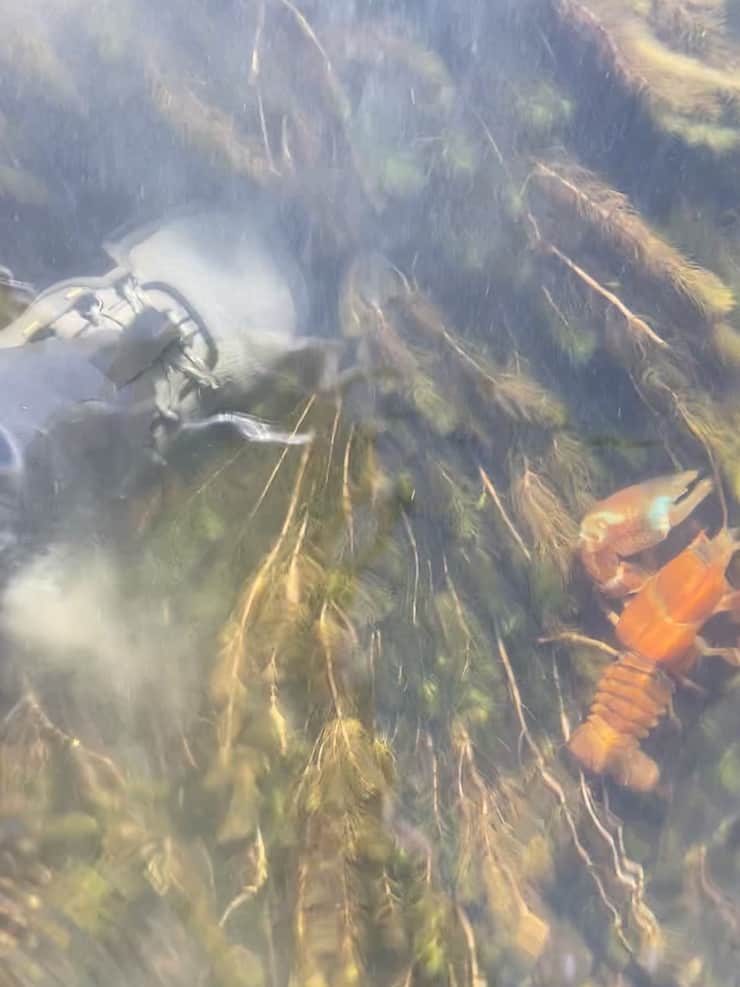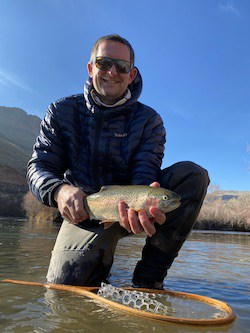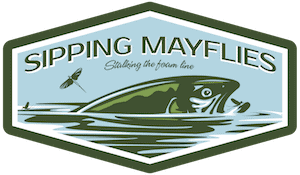Do Trout Eat Crayfish, Crawdads, and Crawfish?
May 27th, 2022
Crayfish are a favorite food of trout, especially larger brown (Salmo trutta), rainbow (Oncorhynchus mykiss), and bull trout (Salvelinus confluentus). Smaller trout, such as brook trout (Salvelinus fontinalis) can also consume smaller-sized crayfish.
Crayfish go by many names, depending upon where in the U.S. you call home. Names include crawdad, crawfish, crawdaddies, rock lobsters, baybugs, mudbugs, mountain lobsters, and craydids.
In the below article, I’ll explain what you need to know about trout and their relationship to crayfish, including pictures and fishing advice.
I took the below picture when I spotted one of several large, red crayfish in a river I was fishing recently. To provide scale, my size 11 wading boot is also in the shot.

Crayfish and Trout
Yes, trout relish eating crayfish as often as they can be found and overpowered. Trout hunt these nutritious crustaceans in the rocks and weeds of lakes and rivers across the country. Their exoskeleton is packed with calcium.
A single crayfish is a calorie-packed meal for any trout, with an average-sized adult containing approximately 77 calories. In other words, crayfish are a huge calorie-boost for any growing fish fortunate enough to catch and eat one.
Young trout must focus on juvenile crayfish, while large trout have the jaws and sharp teeth capable of killing, crushing, and consuming the hard-shelled adults.
Crayfish can reach adult size within 4-5 years, and can live for as long as 30 years.
Which Crayfish do Trout Eat?
There are over 330 species of crayfish/crawdad in the United States alone, and over 500 worldwide. But, the species you’re most likely to see in your local lakes and rivers (and thus get eaten by trout) include:
Signal crayfish (Pacifastacus leniusculus) This is a very invasive species of crayfish that is actively taking over the territories of native crayfish. It’s a drab brown color and has white bands at the joints of its claws.
Rusty crayfish (Orconectes rusticus) This is another invasive species, but very common across the nation. They are a bright red, with long claws. Their claws also have bumps on them.
Red swamp crayfish (Procambarus clarkii) This species is brown to olive, but has very large bumps (tubercules) on its claws, much like a lobster.
Northern crayfish (Orconectes virilis) This species is hugely invasive, and can be identified by the rusty blotches on the sides of its carapace, and their black-tipped claws. I often caught these in ponds, lakes, and creeks growing up.
Where do Crayfish live?
Crayfish live on the bottoms of lakes, ponds, streams, and rivers where you’re most likely to find them in and around submerged rocks and debris near the shoreline. They never wander out of the water unless they need to find a new home.
They’re entirely aquatic, relying upon their gills to pull oxygen from the water.
Crayfish aren’t endangered, and some of them reproduce year-round, like the warm-water red swamp crayfish. Females carry their egg clutches under their tails until they hatch.
Interestingly, they can regenerate lost limbs and have very good eyesight.
Crawdads are the official state crustacean in Louisiana, where they are found in abundance.
I once caught a crayfish on a beadhead nymph, and I’m still not sure how it happened.
Here’s a short video I took of a crayfish escaping into its rock home while I was fishing for trout in a nearby river. Notice it walks forwards, not backwards. Crayfish always walk forwards, and swim backwards.
Can You Use Crayfish as Bait for fishing?
Crayfish are eaten by nearly every predatory fish, including trout, and as such make very effective live bait when fishing. There are many excellent imitations as well, including artificial lures and fly patterns that emulate crayfish extremely well.
When using them as live bait, carefully push the hook through the bony beak between their eyes. This will cause them no pain, and will allow them to swim freely, which of course is going to attract trout and other fish such as largemouth bass, smallmouth bass, catfish, carp, and northern pike.
If you’re using an artificial lure or fly pattern, allow the crayfish imitation to sink to the bottom, and then jig or strip it in slowly. Crayfish are always on the bottom, so keep your lure there.
If you’re fishing with live crayfish from another body of water, make sure they don’t have zebra mussels attached to their exoskeleton. Zebra mussels are a terribly invasive and destructive pest.
What do Crayfish Eat?
Crayfish are omnivorous and will consume plant and animal material, including insects, worms, minnows, aquatic plants, scuds, plankton, and carrion (dead organic material).
The more they eat, the faster they grow, and the more often they must molt (shed their exoskeleton). They usually consume their molt for added nutrients and calcium.
Summary
Crayfish are strong, hardy crustaceans that are a favorite food of many trout, largemouth bass, smallmouth bass, carp, perch, and northern pike. Even sturgeon won’t miss an opportunity to eat one.
If you’re using them as live bait, focus your efforts closer to the shoreline rather than deep water. If you can find rocky outcrops anywhere in a lake, dropping a crayfish down will likely yield you a smallmouth bass, if they live in your waters.

About the Author
My name's Sam and I'm a fly fishing enthusiast just like you. I get out onto the water 80+ times each year, whether it's blazing hot or snow is falling. I enjoy chasing everything from brown trout to snook, and exploring new waters is something I savor. My goal is to discover something new each time I hit the water. Along those lines, I record everything I learn in my fly fishing journal so I can share it with you.
Follow me on Instagram , YouTube, and Facebook to see pictures and videos of my catches and other fishing adventures!


